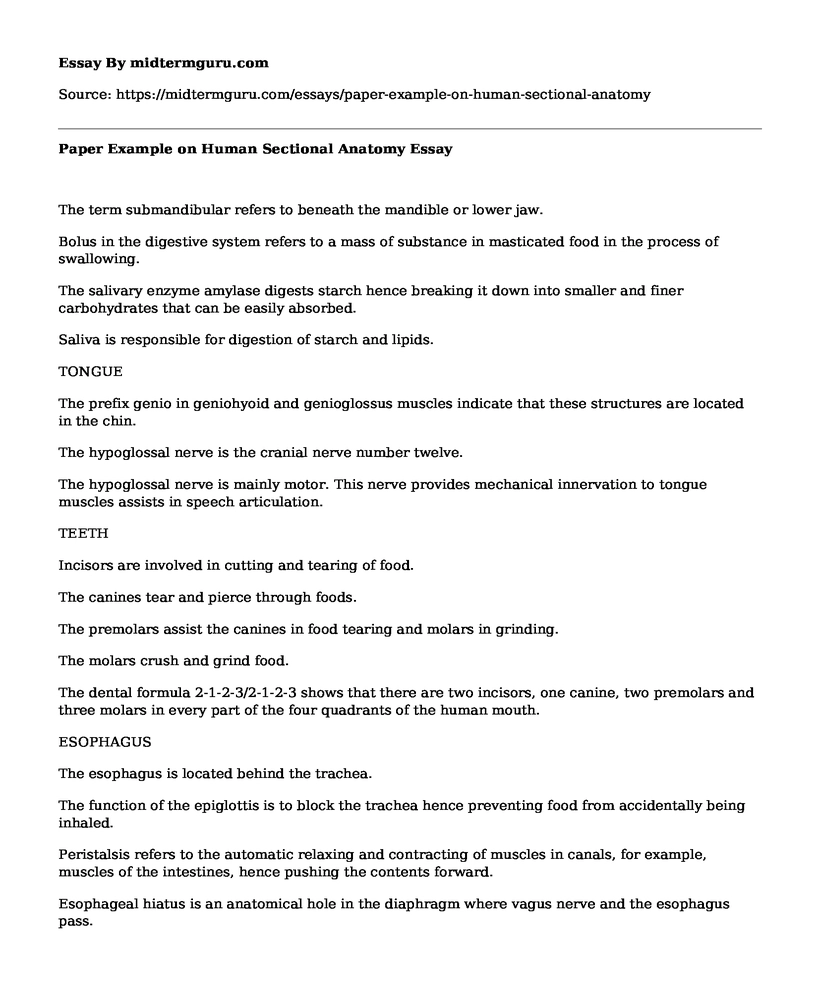The term submandibular refers to beneath the mandible or lower jaw.
Bolus in the digestive system refers to a mass of substance in masticated food in the process of swallowing.
The salivary enzyme amylase digests starch hence breaking it down into smaller and finer carbohydrates that can be easily absorbed.
Saliva is responsible for digestion of starch and lipids.
TONGUE
The prefix genio in geniohyoid and genioglossus muscles indicate that these structures are located in the chin.
The hypoglossal nerve is the cranial nerve number twelve.
The hypoglossal nerve is mainly motor. This nerve provides mechanical innervation to tongue muscles assists in speech articulation.
TEETH
Incisors are involved in cutting and tearing of food.
The canines tear and pierce through foods.
The premolars assist the canines in food tearing and molars in grinding.
The molars crush and grind food.
The dental formula 2-1-2-3/2-1-2-3 shows that there are two incisors, one canine, two premolars and three molars in every part of the four quadrants of the human mouth.
ESOPHAGUS
The esophagus is located behind the trachea.
The function of the epiglottis is to block the trachea hence preventing food from accidentally being inhaled.
Peristalsis refers to the automatic relaxing and contracting of muscles in canals, for example, muscles of the intestines, hence pushing the contents forward.
Esophageal hiatus is an anatomical hole in the diaphragm where vagus nerve and the esophagus pass.
STOMACH
The two Gastrointestinal Tract structures connected at the cardiac orifice are the stomach and the esophagus.
The structures connected at the pyloric sphincter are stomach and duodenum.
In a hiatal hernia, some part of the stomach projects above the surface of the diaphragm via the esophageal hiatus.
ABDOMINAL CAVITY
The lesser omentum rises from the lesser curvature of the stomach.
The greater omentum rises from the greater curvature of the stomach.
The omenta encompass nerves, blood, and lymphatic vessels.
SMALL AND LARGE INTESTINES
The three portions of the small intestines are duodenum, jejunum, and ileum.
The mesentery absorbs nutrients from the lumen of the small intestines. The mesentery supports the bowels via attachments to the abdominal wall posteriorly.
The ileum is the part of the small intestines that connects to the large intestines.
The cecum connects to the small intestines.
Hepatic flexure is the curvature at the intersection of the transverse colon and the ascending colon.
The splenic flexure is a curve at the connection between the transverse colon and the descending colon.
Tenia coli is the band that runs across the medial surface of the colon.
Vermiform is a vestigial organ and has no role.
Sigmoid means S-shaped.
LIVER AND GALLBLADDER
The gallbladder is positioned in the right lobe of the liver.
The liver produces bile which emulsifies fat.
The gallbladder stores bile.
The cystic duct connects the common bile duct to the gallbladder.
The hepatic duct carries bile from the liver to the common bile duct.
The common hepatic artery supplies blood to the liver, duodenum, pancreas and pylorus.
Pancreas and Surrounding Ducts.
The common bile duct is formed by a merger of the common hepatic duct and cystic duct.
The common bile duct empties its contents into the duodenum.
The pancreas has both endocrine and exocrine functions by producing insulin which regulates blood sugar.
Products of the pancreas comprise of proteases, pancreatic lipase, amylase, water, and also bicarbonate.
PANCREAS
The Islet of Langerhans are the known endocrine regions of the pancreas.
Beta cells of the pancreas produce insulin.
The alpha cells of the pancreas produce glucagon.
Glucagon prevents blood glucose from decreasing to critical levels through glycogenolysis.
Insulin regulates the use of stored fats and glucose in the body.
TESTES
Testosterone is the hormone that is produced by the testes.
Testosterone promotes expression of secondary male traits like increased muscle, hair and deepening of the voice.
References
Barrett, G. W. F., & Kim, E. (2012). Ganongs review of medical physiology, vol. Lange medical book. Appleton Lange.
Dixon, A. K., Bowden, D. J., Ellis, H., & Logan, B. M. (2015). Human sectional anatomy: atlas of body sections, CT and MRI images. CRC Press.
Gosling, J. A., Harris, P. F., Humpherson, J. R., Whitmore, I., & Willan, P. L. (2016). Human anatomy, color atlas and textbook. Elsevier Health Sciences.
Cite this page
Paper Example on Human Sectional Anatomy . (2021, Jun 17). Retrieved from https://midtermguru.com/essays/paper-example-on-human-sectional-anatomy
If you are the original author of this essay and no longer wish to have it published on the midtermguru.com website, please click below to request its removal:
- Discussion on Environmental Services on Areas That Inhibit the Growth of Bacteria - Paper Example
- Human Adaptation to Climate: Annotated Bibliography
- Memory, Learning, Creativity and Intelligence Interrelation - Essay Sample
- Computers: A New Way to Connect Human Brains - Essay Sample
- GMOs: Controversy and Benefits of a Technological Discovery - Essay Sample
- Reflective Essay on American Museum of Natural History
- Paper Example on Bio-Cultural Diversity







